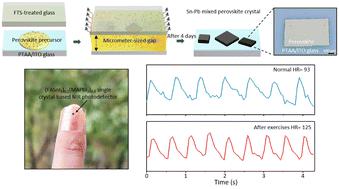Our official English website, www.x-mol.net, welcomes your
feedback! (Note: you will need to create a separate account there.)
Narrow-bandgap Sn–Pb mixed perovskite single crystals for high-performance near-infrared photodetectors
Nanoscale ( IF 5.8 ) Pub Date : 2023-02-03 , DOI: 10.1039/d2nr05800f Zhizhen Chang 1 , Zhengjun Lu 1 , Wei Deng 1 , Yandi Shi 1 , Yuye Sun 1 , Xiujuan Zhang 1 , Jiansheng Jie 1, 2
Nanoscale ( IF 5.8 ) Pub Date : 2023-02-03 , DOI: 10.1039/d2nr05800f Zhizhen Chang 1 , Zhengjun Lu 1 , Wei Deng 1 , Yandi Shi 1 , Yuye Sun 1 , Xiujuan Zhang 1 , Jiansheng Jie 1, 2
Affiliation

|
Narrow-bandgap Sn–Pb mixed perovskite single crystals are highly promising as photoactive materials for efficient and low-cost near-infrared (NIR) photodetectors. However, because of the significant difference in the crystallization velocities for Pb- and Sn-based perovskites, Sn–Pb mixed perovskites are peculiarly prone to phase separation during the crystallization process, causing the degradation of the optical and electronic properties of materials. Herein, we propose a low-temperature space-confined technique (LT-SCT) that simultaneously reduces the crystallization velocities of pure Sn and Pb perovskites, enabling the fabrication of pure-phase (FASnI3)0.1(MAPbI3)0.9 single crystals. The resulting (FASnI3)0.1(MAPbI3)0.9 single crystals exhibit excellent crystallinity with a high hole mobility of 7.44 × 103 cm2 V−1 s−1 and a low surface trap density of 1.88 × 109 cm−2. These properties benefit the application of (FASnI3)0.1(MAPbI3)0.9 single crystals in self-powered NIR photodetectors and yield outstanding comprehensive performance, especially with a broad linear dynamic range of up to 163.5 dB, a large responsivity (R) of 0.53 A W−1, and a fast response speed of 22.78 μs in the NIR spectral region (750–860 nm). Furthermore, high-quality NIR imaging and wearable health monitoring are achieved by employing high-performance and self-driven NIR photodetectors. This work contributes to developing Sn–Pb mixed perovskite single crystals and provides a promising candidate for efficient and low-cost NIR photodetection.
中文翻译:

用于高性能近红外光电探测器的窄带隙 Sn-Pb 混合钙钛矿单晶
窄带隙 Sn-Pb 混合钙钛矿单晶作为高效和低成本近红外 (NIR) 光电探测器的光敏材料非常有前途。然而,由于铅基钙钛矿和锡基钙钛矿的结晶速度存在显着差异,锡铅混合钙钛矿在结晶过程中特别容易发生相分离,导致材料的光学和电子性能下降。在此,我们提出了一种低温空间限制技术 (LT-SCT),可同时降低纯 Sn 和 Pb 钙钛矿的结晶速度,从而能够制造纯相 (FASnI 3 ) 0.1 ( MAPbI 3 ) 0.9单晶。由此产生的 (FASnI 3) 0.1 (MAPbI 3 ) 0.9单晶表现出优异的结晶度,具有 7.44 × 10 3 cm 2 V −1 s −1的高空穴迁移率和 1.88 × 10 9 cm −2的低表面陷阱密度。这些特性有利于 (FASnI 3 ) 0.1 (MAPbI 3 ) 0.9单晶在自供电 NIR 光电探测器中的应用,并产生出色的综合性能,特别是具有高达 163.5 dB 的宽线性动态范围,大响应率 ( R ) 0.53 AW -1,并且在 NIR 光谱区域(750–860 nm)中具有 22.78 μs 的快速响应速度。此外,通过采用高性能和自驱动的近红外光电探测器,可以实现高质量的近红外成像和可穿戴健康监测。这项工作有助于开发 Sn-Pb 混合钙钛矿单晶,并为高效和低成本的 NIR 光电检测提供了有希望的候选者。
更新日期:2023-02-03
中文翻译:

用于高性能近红外光电探测器的窄带隙 Sn-Pb 混合钙钛矿单晶
窄带隙 Sn-Pb 混合钙钛矿单晶作为高效和低成本近红外 (NIR) 光电探测器的光敏材料非常有前途。然而,由于铅基钙钛矿和锡基钙钛矿的结晶速度存在显着差异,锡铅混合钙钛矿在结晶过程中特别容易发生相分离,导致材料的光学和电子性能下降。在此,我们提出了一种低温空间限制技术 (LT-SCT),可同时降低纯 Sn 和 Pb 钙钛矿的结晶速度,从而能够制造纯相 (FASnI 3 ) 0.1 ( MAPbI 3 ) 0.9单晶。由此产生的 (FASnI 3) 0.1 (MAPbI 3 ) 0.9单晶表现出优异的结晶度,具有 7.44 × 10 3 cm 2 V −1 s −1的高空穴迁移率和 1.88 × 10 9 cm −2的低表面陷阱密度。这些特性有利于 (FASnI 3 ) 0.1 (MAPbI 3 ) 0.9单晶在自供电 NIR 光电探测器中的应用,并产生出色的综合性能,特别是具有高达 163.5 dB 的宽线性动态范围,大响应率 ( R ) 0.53 AW -1,并且在 NIR 光谱区域(750–860 nm)中具有 22.78 μs 的快速响应速度。此外,通过采用高性能和自驱动的近红外光电探测器,可以实现高质量的近红外成像和可穿戴健康监测。这项工作有助于开发 Sn-Pb 混合钙钛矿单晶,并为高效和低成本的 NIR 光电检测提供了有希望的候选者。

































 京公网安备 11010802027423号
京公网安备 11010802027423号